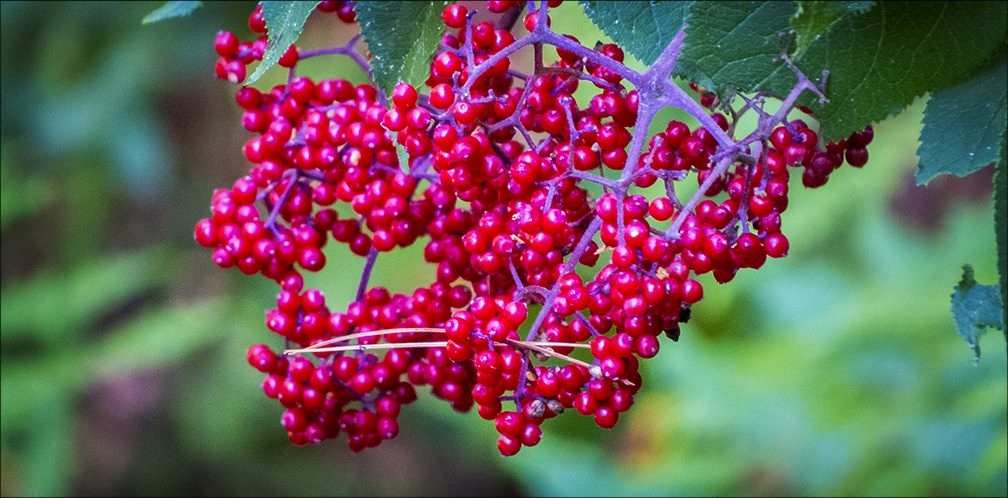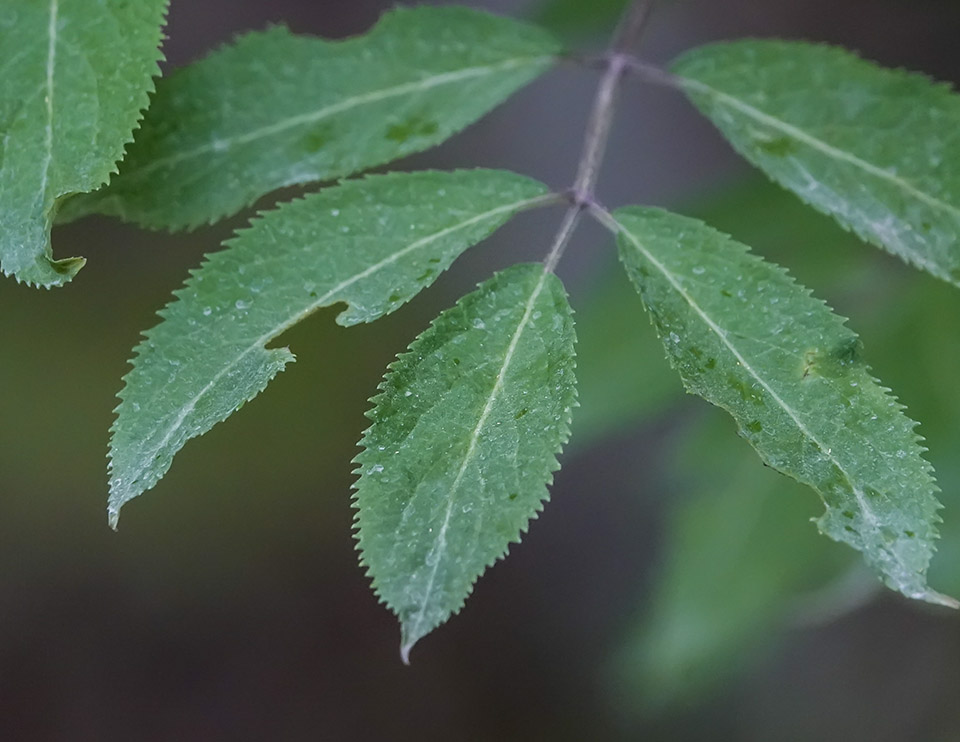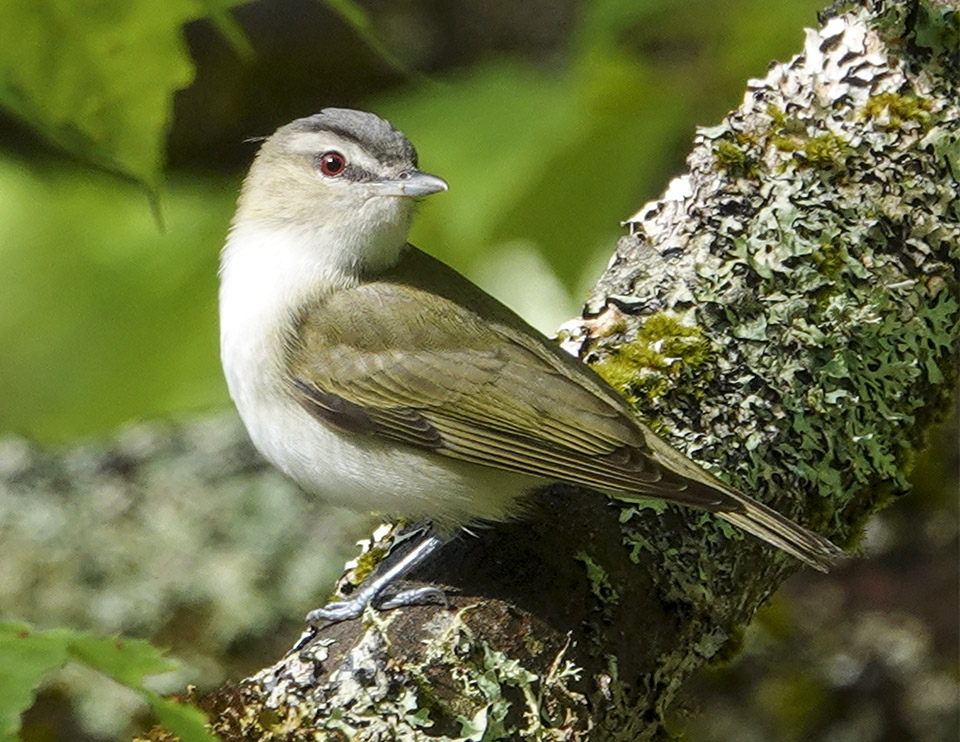Shrubs of the Adirondacks:
Red Elderberry (Sambucus racemosa)

The Red Elderberry (Sambucus racemosa) is a large native deciduous shrub or small tree. It produces clusters of tiny white or cream flowers in early spring, followed by bright red berries in mid-July through early August in the Adirondack Mountains. It grows in well-drained sites in the northern hardwood and mixed wood forests.
Red Elderberry is a member of the Honeysuckle family. It is also known as Scarlet Elder, Stinking Elderberry, Stinking Elder, Red-berried Elder, Bunchberry Elder, and Red Elder.
Identification of the Red Elderberry

Red Elderberry is a tall shrub which can grow 4-12 feet tall in our area. It begins growth early in spring, when it produces large branching clusters of tiny white or cream flowers. The flowers are about 1/4 inch in diameter and have five petals. When closed, the flower buds are pink; when open, the flowers are white, cream, or yellowish. The flowers are fragrant, sometimes attracting hummingbirds and butterflies. The flower stalks are light green. Red Elderberry buds appear in early May. The shrub blooms in the latter half of May in the Adirondacks.
The leaves and stems of Red Elderberry are opposite (meaning that they grow directly across from one another on opposite sides). The leaves are compounds in groups of five or seven. The individual leaflets are lance-shaped to narrowly oval, two to four inches long, tapering to a pointed tip. The edges are finely and irregularly serrated. The foliage has a distinctive, disagreeable odor when crushed. The bark of the Red Elderberry is brownish-grey on older specimens.
The fruit of the Red Elderberry consists, as implied by the name, of bright red berries. Each berry is ¼ inch or less in diameter and contains 3 to 5 stone-like seeds. The berries appear from mid-July through the first week of August in the Adirondacks.
Uses of the Red Elderberry
Red Elderberry does not rank high on the list of edible and medicinal plants, because its stems, bark, leaves, and roots contain cyanide-producing toxins. Its berries, which are poisonous if eaten raw, are said to be safe to eat when cooked and were reportedly used as an ingredient in a variety of recipes by Native Americans. Some used the berry to make wine. Others cooked the fruit to make jelly and jam.
Red elderberry has a number of medicinal uses. Many native American groups reportedly used parts of the plant as an emetic in cases of poisoning. The roots were rubbed on the skin for aching, tired muscles or used as a foot bath for aching legs and feet. One group of native Americans used a decoction of flowers as a cough medicine.
A related shrub – Sambucus canadensis ( Common Elderberry) – appears to have wider uses as an edible and medicinal plant. Its berries are dark purple when ripe.
Wildlife Value of the Red Elderberry

Red Elderberry provides fair to good food and cover for birds and and some insects. Hummingbirds and butterflies collect nectar from the flowers. Although these shrubs are usually not abundant enough at any single site for the fruits to provide significant amounts of wildlife food, many birds, especially Red-eyed Vireos, Ruffed Grouse, Song Sparrows, woodland thrushes, Gray Catbirds, and Brown Thrashers, relish them. In the Northeast, at least 50 passerine and 6 game bird species reportedly consume the fruits.
The shrub is moderately useful to mammals, providing habitat, cover, and food. The Eastern Chipmunk, American Black Bear, Raccoon, and Red Squirrel reportedly eat the fruit. The foliage, because it contains cyanide, is usually avoided by herbivores, although the White-Tailed Deer may browse on it occasionally. Although not a preferred browse, Red Elderberry foliage is highly nutritious. Porcupines, mice, and Snowshoe Hares consume Red Elderberry buds and bark in winter.
Distribution of the Red Elderberry
Red Elderberry is widely distributed in North America. It occurs from Alaska and the Yukon south to California, New Mexico, South Dakota, Missouri, and Georgia and east to Quebec, Newfoundland, Maine, and North Carolina. The plant is widespread throughout its range.
In New York State, Red Elderberry has been documented in many counties. It is common in the Adirondack Park, where it occurs between 100 feet on the Four Brother Islands in Lake Champlain to 3830 feet on Lyon Mountain. Vouchered plant specimens for Red Elderberry have been documented in all counties within the Adirondack Park.
Habitat of the Red Elderberry
In the Eastern United States, Red Elderberry is a part of the understory of climax deciduous forests, including the Northern Hardwood Forest. This plant can also grow in Mixed Wood Forests, rocky forested slopes, roadsides, forest edges and openings, and thickets. Red Elderberry, while common in many forest communities, is rarely dominant, generally occurring in scattered patches or as isolated individuals. Although the plant usually occurs in non-wetlands, it is seen occasionally in wetlands. It can sometimes be found growing in riparian zones (adjacent to rivers or streams). The Red Elderberry in the photos above was found growing near Barnum Brook on the Barnum Brook Trail at the Paul Smiths VIC.
References
Michael Kudish. Adirondack Upland Flora: An Ecological Perspective (Saranac, New York: The Chauncy Press, 1992), pp. 192-193.
John Kricher. A Field Guide to Eastern Forests. North America (Boston: Houghton Mifflin, 1998), pp. 77.
William K. Chapman and Alan E. Bessette. Trees and Shrubs of the Adirondacks: A Field Guide (Utica, New York: North Country Books, 1990), p. 105, Plate 28.
Alexander C. Martin, Herbert S. Zim, and Arnold L. Nelson. A Guide to Wildlife Food Habits (New York: Dover Publications, 1951), pp. 362-363.
John Eastman. The Book of Forest and Thicket: Trees, Shrubs, and Wildflowers of Eastern North America (Stackpole Books, 1992), pp. 75-76.
William Carey Grimm. The Illustrated Book of Wildflowers and Shrubs (Stackpole Books, 1993), pp. 592-593.
Donald W. Stokes. The Natural History of Wild Shrubs and Vines (Harper & Row, 1981), pp. 231-235.
United States Department of Agriculture. Plants Database. Retrieved 7 February 2017.
United States Department of Agriculture. Natural Resources Conservation Service. Red Elderberry. Sambucus racemosa L. Retrieved 7 February 2017.
United States Department of Agriculture. US Forest Service. Sambucus racemosa. Retrieved 7 February 2017.
New York Flora Association. New York Flora Atlas. Sambucus racemosa. Retrieved 7 February 2017.
iNaturalist. Adirondack Park Observations. Red-berried Elder. Sambucus racemosa. Retrieved 14 April 2021.
Northern Forest Atlas. Images. Sambucus Racemosa. Red Elderberry. Retrieved 4 February 2017.
Lady Bird Johnson Wildflower Center. Plant Database. Retrieved 7 February 2017.
Illinois Wildflowers. Red Elderberry. Sambucus racemosa. Retrieved 7 February 2017.
Native Plant Trust. Go Botany.Red Elderberry. Sambucus racemosa L. Retrieved 14 April 2021.
Minnesota Wildflowers. A Field Guide to the Flora of Minnesota. Sambucus racemosa. Retrieved 7 February 2017.
Plants for a Future. Database. Retrieved 7 February 2017.
Encyclopedia of Life. Sambucus racemosa. Retrieved 7 February 2017.
University of Wisconsin. Shrubs of Wisconsin. Sambucus racemosa. Retrieved 7 February 2017.
University of Michigan. Native American Ethnobotany. A Database of Foods, Drugs, Dyes and Fibers of Native American Peoples, Derived from Plants. Sambucus racemosa L. Retrieved 7 February 2017.
The Cornell Lab of Ornithology. Birds of North America. Subscription Web Site. Song Sparrow, Red-eyed Vireo. Retrieved 14 April 2021.
